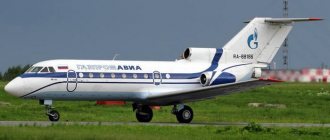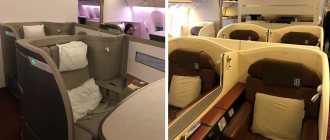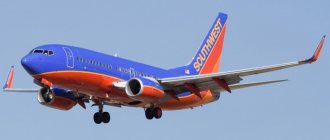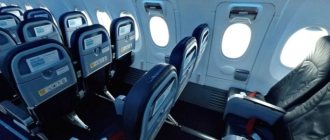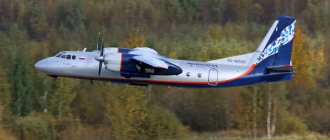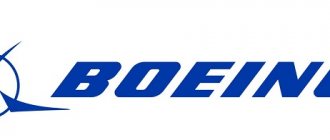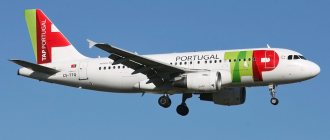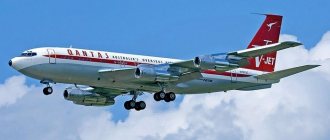The four-engine Boeing 707, along with the Soviet Tu-104, the French Sud Aviacion Caravelle and the British de Havilland DH.106 Comet, is one of the first jet airliners in the world produced for passenger air travel. Also, starting with the Boeing 707, the foundations were laid for the dominance of American jet aircraft in the passenger air transportation market. Depending on the modification, the flight range of the 707 can range from 4,650 to 10,550 kilometers. Various versions of the Boeing 707 aircraft can accommodate up to 189 passengers in their cabin.
According to its concept, the Boeing 707 is a narrow-body, four-engine aircraft, shaped like a monoplane with a low swept wing, under which turbojet engines are located in nacelles.
The prototype for the entire 707 family was the Boeing 367-80, also known as the Dash-80. Construction of the Boeing 367-80 began in 1952, and already on May 14, 1954 the aircraft was ready. The length of the finished aircraft was 39.97 meters with a wingspan of 39.88 meters. About $16 million was spent on the construction of the Boeing 367-80. The flight of this prototype took place on July 15, 1954.
Boeing 707 photo
The name of the prototype was later changed to Model-707. Since the start of flight testing, an order has been received from the US Air Force to develop a tanker jet. An extended version of the Model-707 aircraft was chosen as the basis for this project. The prototype tanker aircraft was designated Model-717. Production aircraft will later be designated C-135 Stratolifter and KS-135 Stratotanker.
But as for the airliner for passenger transportation, there was a competitor in the form of the Douglas DC-8 jet aircraft, produced by the American company. For this reason, I had to modernize my project. The new aircraft was designated Boeing 707-120. On this aircraft the cross-section and length of the fuselage were increased. This made it possible to place three chairs in one row. Thanks to this, passenger capacity was increased. The length of the Boeing 707-120 aircraft was now 44.07 meters. The airliner was equipped with Pratt & Whitney JT3D-6 engines with a thrust of 60.02 kN. Orders for the Boeing 707-120 began arriving in mid-1955. The first customer of the new airliner was the airline. This plane first took to the skies on December 20, 1957. The Boeing 707-120 began operating regular passenger flights on domestic American flights up to 5,000 kilometers in August 1958.
In December 1955, work also began on building an aircraft for intercontinental flights. The main customer of the new transatlantic aircraft was the same Pan American. The aircraft was designated Boeing 707-320. This model has an enlarged fuselage, thanks to which the length of the Boeing 707-320 is 46.61 meters. The wingspan and fuel tank capacity were also increased. Initially, the aircraft was equipped with Pratt & Whitney JT4A-3 engines with a power of 71.5 kN. The Boeing 707-320 made its first flight on January 11, 1959. After certification in August 1959, the aircraft began to be supplied to airlines. At the beginning of 1962, the Boeing 707-320 made its first flight with Pratt & Whitne JT3D-3 engines. Later, Pratt & Whitney JT3D-7 engines with a power of 84.4 kN were used on the aircraft.
The Boeing 707-320 version has become the most popular aircraft of the entire 707 family. This airliner is in economy class and can accommodate up to 189 passengers. With a two-class layout, its cabin can accommodate 147 passenger seats. Its flight range is more than nine thousand kilometers.
In addition to passenger ones, various modifications of the aircraft were produced, intended for transport, cargo and military purposes.
Production of the Boeing 707 aircraft was finally discontinued in 1978. Over the entire production period, 1010 units of Boeing 707 aircraft were produced.
How did Boeing come into being?
The Boeing company was created at the beginning of the twentieth century by William Boeing. Initially, the company produced training aircraft and mail delivery aircraft. This company was also involved in the creation of various military equipment: bombers, torpedo bombers, fighters.
In 1930, one of the first high-speed aircraft called Monomail was produced, which was used to deliver mail. Later, on its basis, the company's developers created the first Boeing 247 passenger airliner. From that moment on, Boeing became a leading manufacturer in the civil aircraft industry.
In 1954, the company produced the world's first jet passenger aircraft, the Boeing 707. The description, history of creation and characteristics of this aircraft will be discussed in detail below. Based on this airliner, a line of passenger aircraft will subsequently be produced, which includes the Boeing 737, Boeing 747, Boeing 757 and Boeing 767. These models have become leaders in the civil aircraft industry. The total number of cars produced exceeded 6.5 thousand units.
Notes[ | ]
- Orders & Deliveries
- ATDB.aero aerotransport.org AeroTransport Data Bank (unspecified)
.
aerotransport.org
. Access date: June 28, 2022. - Harro Ranter.
Aviation Safety Network > ASN Aviation Safety Database > Type index > ASN Aviation Safety Database results
(unspecified)
.
aviation-safety.net
. Access date: June 28, 2022. - Aviation Safety Network > ASN Aviation Safety Database > Aircraft type index > Boeing 707 > Boeing 707 Statistics
- Aviation Photo #1531069: Boeing 707-138B - Qantas (John Travolta) (unspecified)
.
Airliners.net
. Access date: June 28, 2022.
The history of the creation of a flying car
The history of the creation of the Boeing 707 airliner was adventurous from the very beginning. The manufacturing company decided to invest more than $16 million in its design and creation, because it was about developing a unique example of a new generation passenger aircraft, which was supposed to have a turbojet engine. Due to the high degree of secrecy of this machine, it was given the code name “Model 367-80”. Among Boeing employees, the project was known as the Dash 80. And only the company's top management knew that the future name of the new airliner was the Boeing 707.
The Boeing 707 aircraft was presented to the public on May 14, 1954. The new aircraft was created on the basis of two airliner models: the civilian piston Model 377 and the military Model KC-97. In terms of its aerodynamic properties, the Boeing 707 model was close to the B-47 Stratojet military jet aircraft, created in 1950.
The new passenger airliner made its first experimental flight on July 15, 1954, and already on October 13, 1955, the largest air carrier at that time, Pan American, signed a contract with Boeing for the production of six Boeing 707-120 aircraft, the description and characteristics of which are given below.
Change of generations
By the end of the 70s, the airliner became a victim of its own success. Passenger traffic was constantly growing, and the plane could no longer cope with it. The management understood that lengthening the fuselage would help solve the problem, but such measures were inappropriate from an economic point of view. The longer fuselage requires larger and more powerful engines, as well as increased landing gear spacing. In addition, by the end of the 70s, the aircraft was outdated in terms of noise insulation and fuel efficiency. To increase capacity it was necessary to replace the airframe. As a result, Boeing built a new generation model, which received the index 747 and fully satisfied the capacity requirements.
Description of the Boeing 707-120 model
In the fifties of the twentieth century, passenger aircraft construction began to develop rapidly. In this regard, Boeing acquired a serious competitor - McDonnell Douglas Corporation, which was developing the Douglas DC-8 jetliner. This fact influenced the design process of the Boeing 707 aircraft and made some adjustments. The end result of the development process was called the Boeing 707-120.
It was distinguished from the original model of the aircraft by the cross-sectional dimensions and length of the fuselage. These parameters have become larger. Thanks to such technical solutions, the designers were able to increase the number of seats in one row and, accordingly, the number of passenger seats. Also, new engines were installed on the airliner, which made it possible to increase the flight range. Now this figure was 5 thousand kilometers.
Regular flights of this Boeing model began to operate in August 1958.
Flight characteristics
A feature of the technical characteristics of the 707-320 was its long flight range and capacity, which ensured increased economic efficiency of the airliner. Ultimately, these parameters predetermined the success of the aircraft.
The success of the Boeing 707 allowed the company to begin developing new machines, which gradually supplanted many competitors. Today, the market for aircraft for medium and long-haul routes is almost completely divided between Boeing and Airbus.
Description of Boeing 707-138
The Boeing 707-138 passenger airliner was built by special order of the Australian airline Qantas. Boeing engineers were tasked with developing a special version of the 707-120 aircraft, which would have the ability to carry out ultra-long-range flights.
The end result of the work was the creation of a passenger airliner with a fuselage shortened at the rear. Additionally, the payload was reduced and another fuel tank was installed. This model of the Boeing 707 aircraft was produced in limited quantities - only 7 units.
First buyers
The first buyer of the passenger airliner was Pan American, which immediately ordered 20 707-112 aircraft. On the same day, the company purchased 25 Douglas aircraft and negotiated with the latter the possibility of purchasing an additional batch. Douglas, meanwhile, announced the creation of a long-range modification of the DC-8, to which Boeing had to respond by developing the 707-320 Intercontinental aircraft.
Pan American and TWA became not only the first, but also the largest companies to operate the Boeing 707. Thanks to airliners of this model, air carriers have significantly increased the volume of their fleets. The first non-American company to operate this aircraft was Qantas. Following her, various Western European companies began to acquire the liner.
Description of the Boeing 707-320
At the end of 1955, Boeing engineers began work on creating a passenger aircraft that could operate intercontinental flights. The new airliner was named Boeing 707-320. Its fuselage has been enlarged, making the aircraft longer than the 707-120. The airliner's fuel tank has become more spacious. The wing span has also increased. The car was equipped with high-power engines. The new Boeing 707-320 aircraft was the most popular among airliners of its class.
Flight performance[ | ]
| 707-120 | 707-320B | |
| Passengers (2 classes) | 110 | 147 |
| Passengers (1st class) | 179 | 202 |
| Maximum take-off weight | 116,570 kg | 151,320 kg |
| Empty mass | 55,580 kg | 65400 kg |
| Maximum flight range | 6820 km | 9200 km |
| Cruising speed | 917 km/h | 890 km/h |
| Length | 44.07 m | 46.61 m |
| Wingspan | 39.9 m | 44.42 m |
| Keel height | 12,93 | |
| Engines | Four 75.6 kN Pratt & Whitney JT3C-1 turbojet. | Four 80 kN JT3D-3 or four 84.4 kN JT3D-7. |
Boeing 707: interior layout, seats and passenger reviews
Let's look at what this liner is like from the inside. The photo below shows a typical layout of seats and support spaces for a Boeing 707 aircraft.
The interior diagram of this airliner contains the following designations:
- B – buffet;
- C – wardrobe;
- G – kitchen;
- L – toilet;
- LC – hand luggage compartment;
- M – movie screen;
- S – warehouse.
The gray color in the picture shows the cockpit of the Boeing 707 aircraft.
The airliner's cabin contains 151 passenger seats, 16 of which are located in first class (yellow and orange area in the photo), and another 135 in second class (blue and green area).
In the aircraft cabin layout, non-smoking areas are marked in yellow and blue. These include rows one to two and five to eighteen. Smoking areas are marked in orange and green. These are rows three to four and nineteen to twenty-eight.
Reviews from Boeing 707 passengers are positive, despite the fact that this aircraft has long been out of production. This airliner can successfully compete with many modern aircraft in terms of flight quality.
Design
The Boeing 707 is a monoplane with a low-mounted swept wing. The engines are located in separate nacelles on pylons under the wing. The car became the first passenger aircraft with such an engine arrangement. The wings have a constant sweep along the leading edge with an angle of 35⁰.
The use of such a scheme created difficulties for pilots accustomed to operating ortho-wing machines with piston engines. The leading edge of the wing is equipped with deflectable Kruger flaps, designed to reduce the speed of the vehicle during landing.
The design of the aircraft uses a special autopilot that monitors deviations of the aircraft from the course. The Boeing 707 uses a three-post landing gear with a rotating nose gear.
The main supports are equipped with trolleys with two paired wheels with brake mechanisms.
A paired wheel is installed on the nose support. The nose gear can be rotated from the cockpit or using a rigid tow bar. During the takeoff run, control is blocked.
The passenger cabin and cockpit of the aircraft are equipped with an overpressure system and air conditioning. The system operates from air taken from engine compressors. The extraction channel was installed above the engine and covered with a special fairing.
The interior layout is built on the principle of installing two rows of three-seater seats with a central aisle. When installing business class seats, double seats are used, installed in the forward part of the fuselage.
Other modifications of the Boeing 707
In addition to the passenger version of this aircraft, Boeing also produced other modifications for various purposes.
For example, on the basis of this model, the world's first refueling aircraft, the KS-135, was created, which was used by the air forces of various countries. This airliner served for several decades in these units of the USA, France, Turkey and other countries.
Another modification of the Boeing 707 was the long-range radar detection aircraft called the E-3 AWACS. This airliner was created specifically for the US Air Force and performed the job of detecting enemy aircraft by scanning space using an oblique-return method.
Also based on the Boeing 707, the special purpose aircraft VC-137 was built, which was Air Force One and was used to transport US presidents. Only two of these aircraft saw the light of day. They are both currently in the US Air Force Museum.
Based on the Boeing 707 aircraft, a number of military transport modifications of such an airliner were created. All these machines, despite their advanced age, are currently successfully coping with the tasks assigned to them.
Non-standard technologies
When creating the B707, the latest developments were used and risky decisions were made.
First: each of the four engines was placed in separate, isolated engine nacelles for the first time. This made the flight more reliable, because in the event of a possible fire, the fire would not spread to other engines.
Another novelty was that the engines were located under the wing, providing better aerodynamic conditions.
Setting a top speed of 1000 km/h, the developers planned that this figure would be three times higher than competitors Douglas DC-7 and Lockheed Super Constellation.
In the new prototypes, the cross-section of the fuselage was increased to accommodate 3/3 seats for greater passenger capacity. New portholes and interior panel upholstery were designed.
The engines were equipped with a water injection system, thereby increasing traction force. With the help of a special development, the noise component was reduced. The fuel compartments were made more voluminous.
John Travolta's Boeing 707
Famous actor John Travolta is the owner of a Boeing 707. A photo of the happy pilot along with his airliner can be seen below.
John Travolta fell in love with airplanes at a young age. Even then, he liked to book air tickets for his family members on his own. John's first flight brought him a lot of impressions. After this, Travolta lived for some time in the city of aviators, in which the main street was replaced by a runway.
In 2003, the actor built his own house in the shape of an airport. There is a 700-meter runway next to the building. It was built for Travolta's personal jets. The actor's favorite is the Boeing 707, which is named after John's children: Jett Clipper Ella. Inside the airliner there are three living rooms, several bedrooms, and an office. This plane became the actor's property in 2002, and Travolta is not going to part with his Boeing, at least not in the near future.
Airplane safety
The most dangerous moment during the entire flight of an airliner is takeoff and landing. Weight at takeoff does not significantly affect the characteristics of the vehicle, but is taken into account during takeoff. If there is an overload, then the strip should be significantly longer than with a minimum mass.
Headwind or tailwind during takeoff does not play a special role; only the side wind is taken into account: it should not exceed 19 m/s, otherwise the risk of massive equipment shifting to the side of the runway increases.
Landing weight is very important: the permissible value for the Boeing 737 800 aircraft is 65.3 tons.
At the moment, more than 200 aircraft have been lost. The first disaster occurred in the USA (Philadelphia), the takeoff was canceled by mistake, it was decided that the engines had failed. After this, the tire rolled off the runway.
More than half of the disasters occurred with the Original 100 and 200 family
One of the latest unpleasant events occurred in the United States. During landing, the plane rolled off the runway and slid into the river. Fortunately, no one was hurt.
The most mysterious Boeing 707 plane crash
Despite the fact that the aircraft model was very successful, accidents still occurred with its participation. Over the entire period of operation of such airliners, 194 aircraft of various modifications crashed. The most mysterious among all these tragic stories remains the one that happened on September 2, 1983. It was then that a Boeing 707, owned by Korean Air Lines from South Korea, was shot down over the territory of the USSR by an SU-15 fighter piloted by a Soviet pilot.
According to the official version, the airliner violated the airspace of the USSR and flew over important classified military facilities. The Boeing crew refused to carry out the command to land the plane at the nearest airfield, as a result of which the plane was shot down and crashed in the southwestern part of Sakhalin Island. As a result of the accident, all passengers and crew members died. US politicians were also present on board. As a result of this incident, an international scandal broke out. To this day, the true reason why the Boeing 707 crashed on September 2, 1983 remains unclear.
Everything comes to an end
By the end of the 60s, the most popular transcontinental passenger airliner ceased to meet operating conditions. The car quickly became obsolete. There is practically no technological base left for subsequent modernization to simply increase passenger capacity by lengthening the cabin. The Boeing 707 had very noisy engines, and the American could not be called an economical car. As a result, aircraft designers had to change the airframe of the aircraft, which ultimately led to the appearance of a new aircraft - the Boeing 747. Despite the quick and sad ending, the legendary airliner continued to be produced until 1978. A total of 1,010 aircraft of various modifications rolled off the assembly line at Boeing factories.
The end of the Boeing 707 era
By the beginning of the 1970s, the airliner could no longer cope with the increased number of passengers by that time. The company's engineers could not extend the fuselage further for technical reasons. Modernization work has become economically unjustified. After all, to solve this problem it would be necessary to create new engines, increase the distances between the aircraft landing gear and make other design changes. In addition, the Boeing 707 was physically outdated, too noisy and uneconomical in terms of fuel. It was not possible to improve the aircraft. This means that a worthy replacement had to be invented. This is how the new Boeing 747 airliner appeared, which could accommodate more passengers and fly longer distances.
By the mid-1970s, fewer and fewer companies showed a desire to purchase such a device. Air carriers in Europe and the USA gradually began to move away from using this model. The main countries that still operated such an aircraft were the developing countries of Asia, Africa and South America. In 1978, serial production of the Boeing 707 was completed, and in 1983 its last regular flight to the United States took place.
By the end of the 1990s, such an aircraft was used in Africa and South America. Its main task was freight transportation. As of the beginning of 2010, 155 Boeing 707s were in service around the world. These were mainly military modifications. Nowadays, the only air carrier that uses such a passenger aircraft is the Iranian company Saha Air.
Current operators
End-of-life Boeing 707s at AMARC storage base
As of the beginning of 2010[1], 155 B-707 type aircraft were in use, almost all in the air forces of a number of countries (aircraft and cargo). Several vehicles are used by civil cargo airlines, 8 by government air squadrons. The last airline to use the B-707 on scheduled passenger flights was Iran's Saha Airlines, which had 5 aircraft in service as of August 10, 2010. However, since April 2013, the company stopped flying, although it itself still exists. Thus, the Boeing 707 is the last of the first generation jetliners that was in service until recently; other “pioneers” of jet passenger aviation went down in history back in the 1980s.
